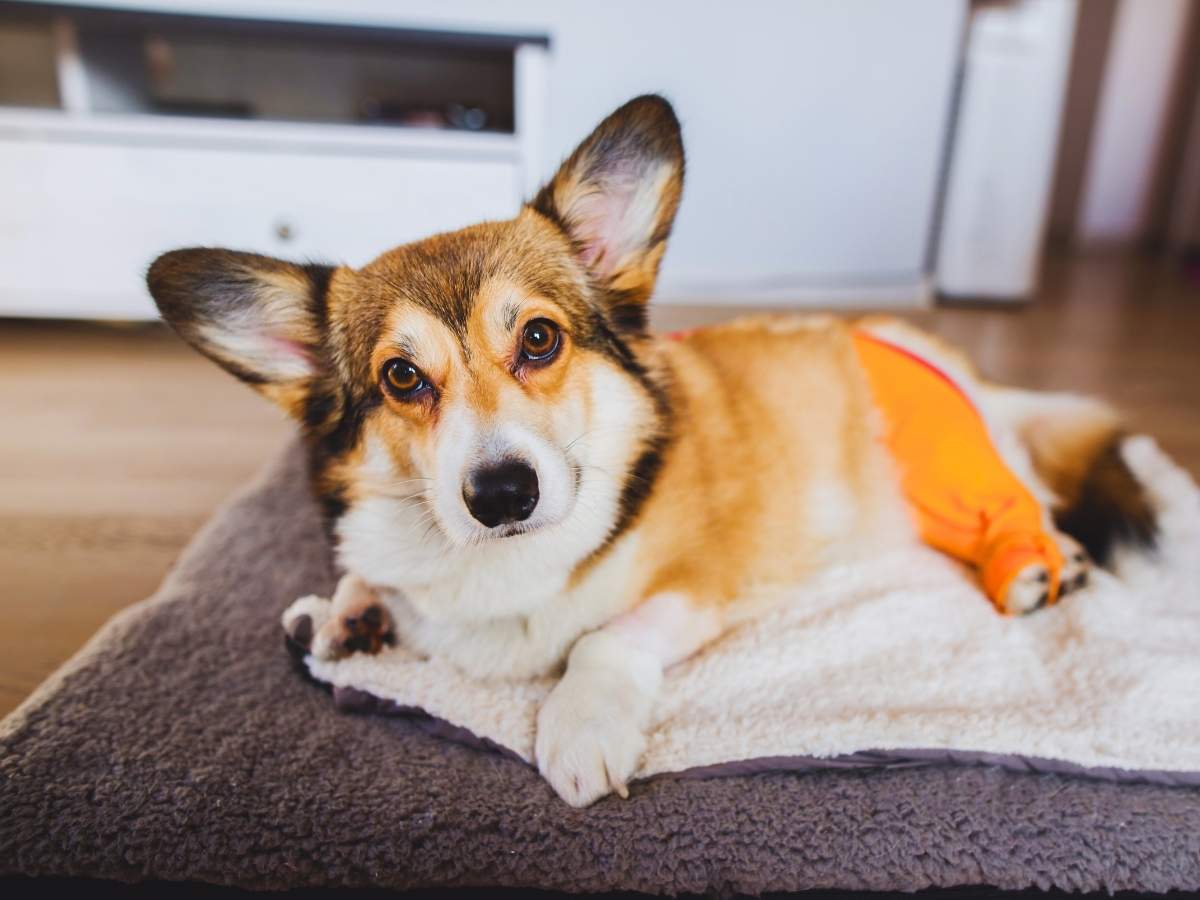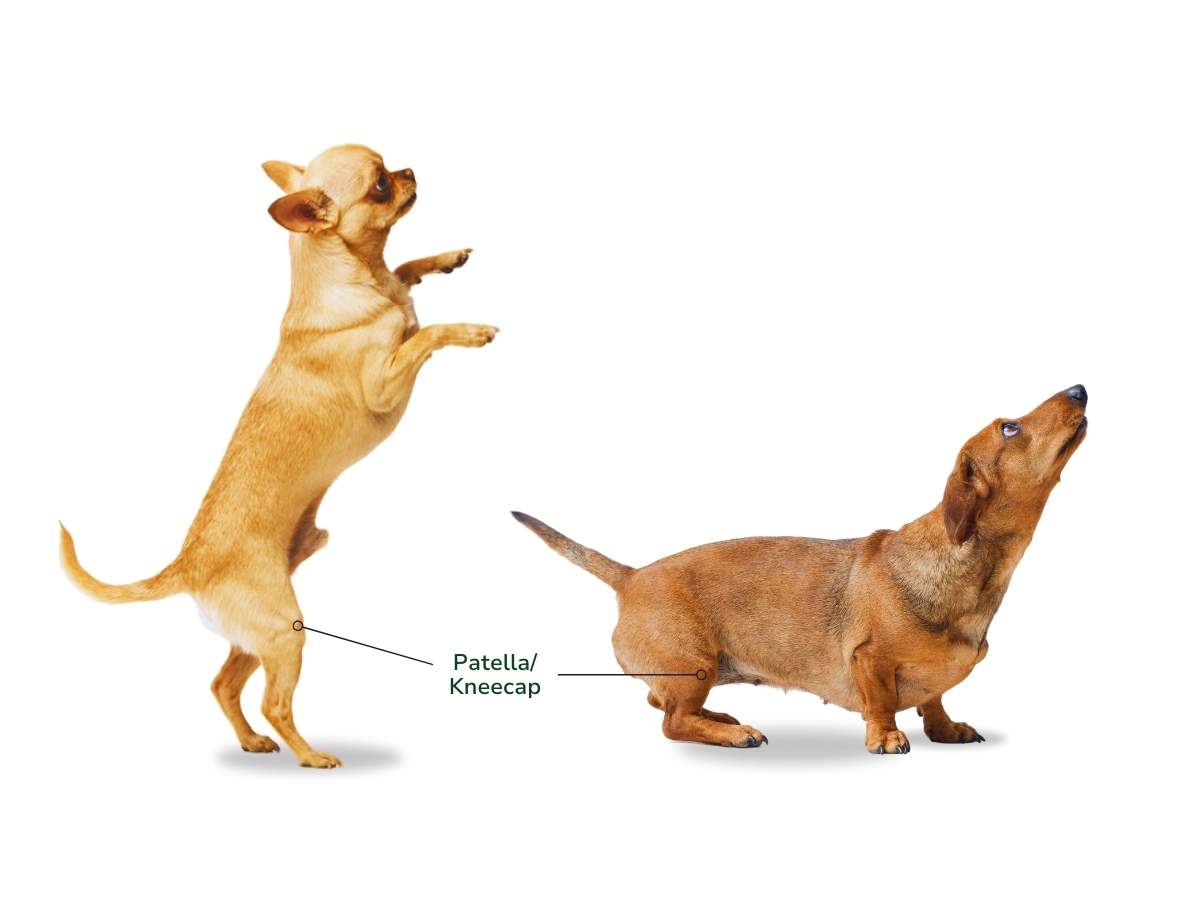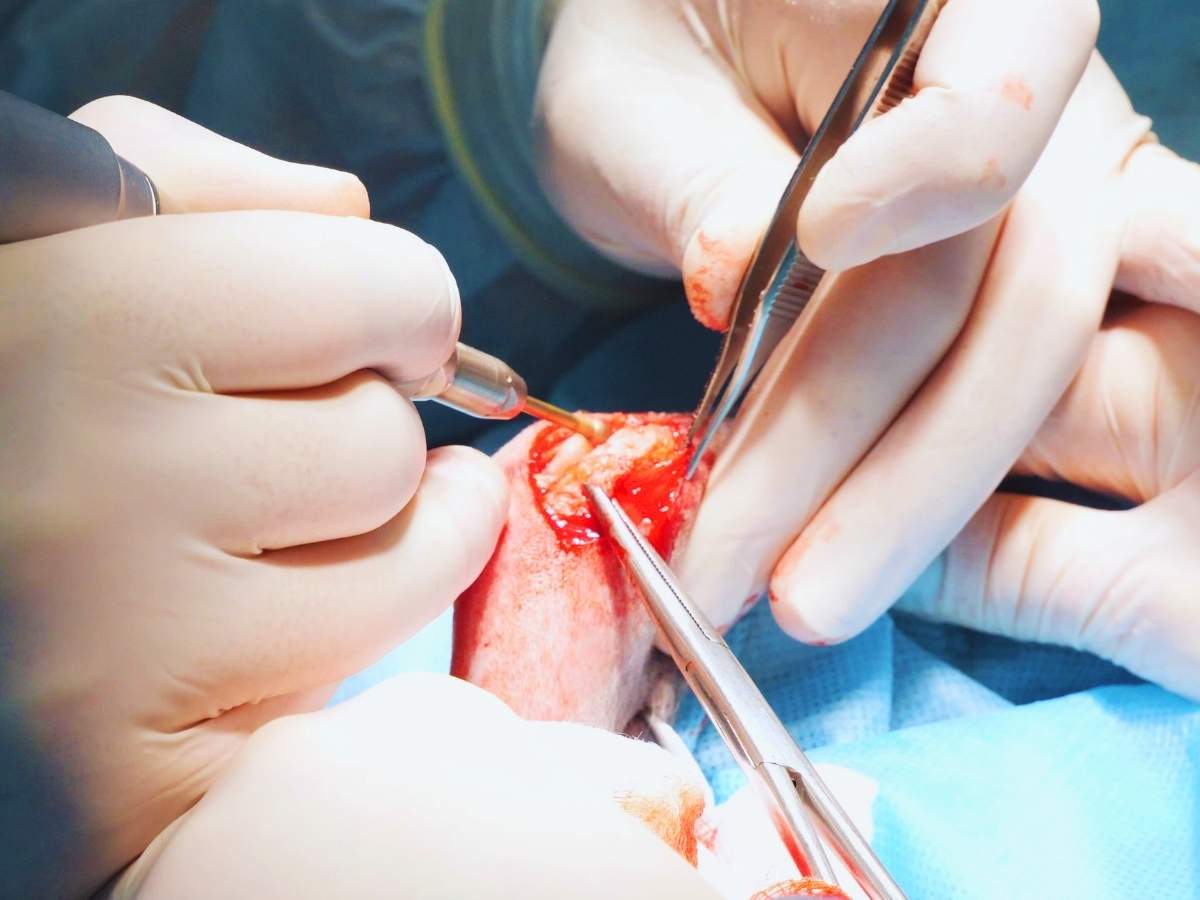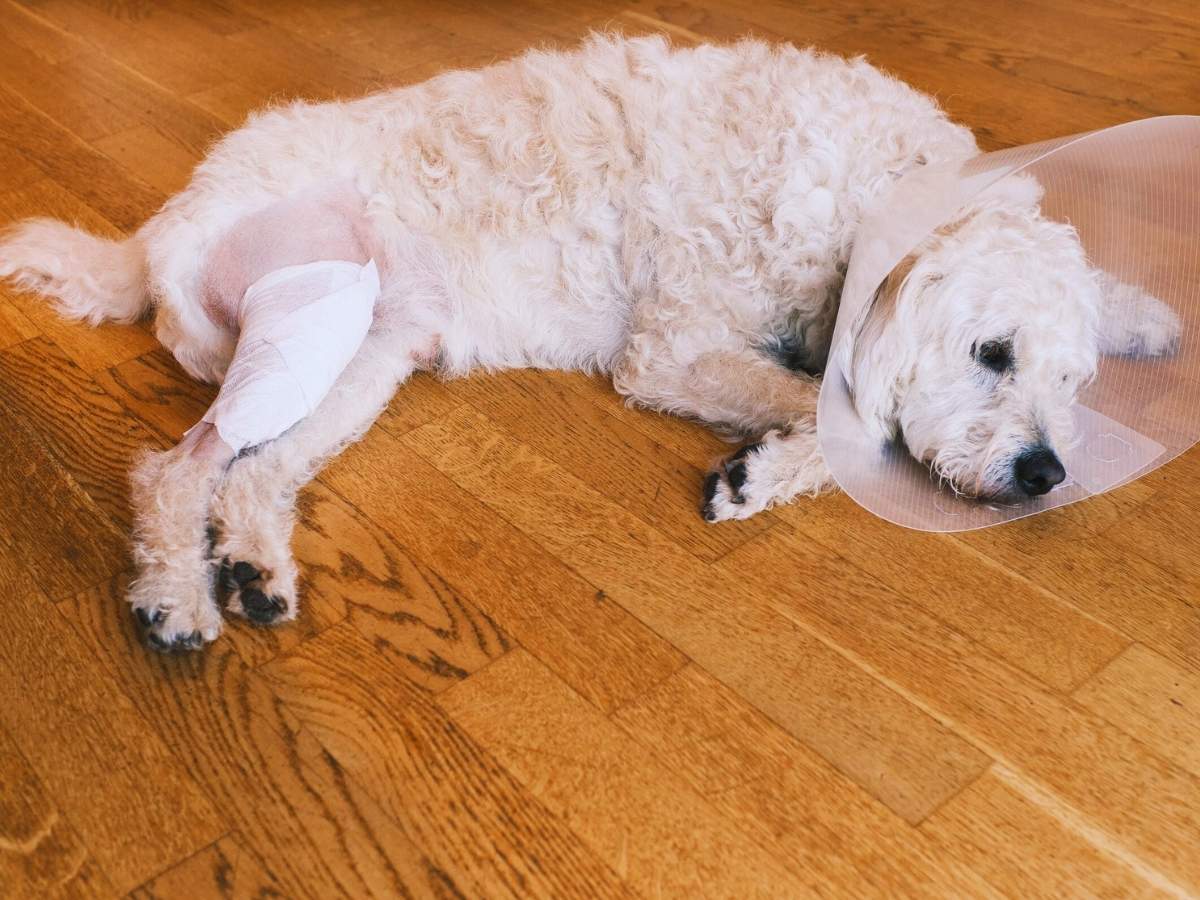Dog Patella Luxation: Symptoms & Causes
Article - 10 min read • Updated Nov 12, 2024
Medically reviewed by Dr. Claire Tan, BVSc (Qld.), BAppSc (Qld.)

Worried that your dog’s limping might be a sign of something serious? Here’s what you need to know without the complex medical jargon.
What is patella luxation?
Patella luxation means the patella (or kneecap) goes out of place or dislocates. This tends to occur when the dog flexes its knee. A common sign is when your dog seems to be ‘skipping’. This can look like he is lifting one of his hind legs suddenly every few steps, while walking or running. Check out this video.
Many factors can contribute to this condition, but it is usually caused by genetics. Popular miniature dog breeds in Singapore such as dachshund, pug and toy poodle etc., are more likely to develop a luxating patella.
How do I know if my dog has a dislocating kneecap?
Firstly, patella luxation only occurs on a dog’s hind or back legs. Symptoms include:

Sudden limp or hop that comes and goes. Especially where your dog lifts his hind leg off the ground briefly before walking or running normally again. It can look like ‘skipping’.
Yelping when this sudden limping happens. Most dogs may not even display any signs of discomfort or pain.
Cracking or popping noises when knee bends
Walking stiffly or awkwardly
Hind or back legs cannot extend properly
Hunched lower back
Schedule a check-up today if you notice these signs in your dog. You can only confirm the diagnosis after your vet has physically examined your dog. In fact, most of the cases we’ve treated here at Gaia Vets were diagnosed by chance, during a routine health check, or during a physical exam for a different problem. This is another reason why we recommend health checks at least once a year for dogs.
Imaging such as x-rays or/and CT scans will then be used to grade the severity of the condition. Low grade or mild cases may only require management but high grade or more severe cases will need corrective surgery.
Why does my dog’s kneecap pop out easily?
There are 2 main reasons for this condition:
The groove where the patella or kneecap sits is not deep enough. This is mostly attributed to hereditary factors. This groove where the kneecap slides up and down, keeps the patellar ligament in place during any movement. So when it is too shallow, the kneecap is able to slip out easily
The point where the patellar ligament is attached may be off centre due to your dog’s confirmation as his bones grow. This attachment causes the ligament to be pulled to the side when the muscle contracts, causing the dislocation. After months or years of this abnormal movement, the inner side of the groove may get worn down. Once this happens, the kneecap will dislocate more easily and can further lead to arthritis.
What problems can patella luxation cause?
If the dislocation is severe and if both legs are affected, your dog won’t be able to walk normally and may be in quite a lot of pain.
Some dogs, especially with a lower grade of patellar luxation, can tolerate this condition for many years with no symptoms. However with ageing, arthritis can develop due to friction from the patella rubbing against the bone whenever it is out of place. This will then cause swelling or joint pain. Once arthritis develops, it cannot be reversed.
Dogs with patellar luxation are also prone to getting cruciate ligament rupture. The ligament (cranial cruciate ligament or CCL) is a connective tissue in the knee connecting the upper leg to the lower leg. The CCL is important for mobility.
Can my dog live with a luxating patella?
Yes, in fact many dogs with mild patella luxation can live with this condition for many years without symptoms. The dog may limp slightly every few steps, but is able to go back to normal after kicking or shaking its hind leg.
Dogs with moderate or more severe conditions will start limping, refuse to walk and may feel quite a lot of pain etc.
Treatment Options For Patella Luxation: Surgery & Alternatives

Can my dog recover from a luxating patella without surgery?

Without surgery, your dog will still have a luxating patella. Some mild cases do continue to be mobile and only require management via medication as and when needed. The knee cap may return to its original normal position without further intervention in such cases, but it is not guaranteed and the problem can return or may worsen with time.
Are there different types of patella luxation?
Yes, there are 2 types i.e. medial and lateral. Medial patella luxation is more commonly seen, with signs often developing during puppy stage. Lateral luxation is less common, but can be seen in medium or large breeds, and is often accompanied by hip dysplasia.
What are the different grades of patella luxation?
There are 4 grades. The higher the grade, the more severe the condition. You may refer to a visual diagram here. Usually there is no need to surgically repair dogs with Grade I. However, Grades II-IV tend to need surgical repair to relieve the symptoms of pain and lack of mobility.
Grade I: The patella can be dislocated out of the groove when you put pressure on it,, but as soon as the pressure is released, the patella goes back in place.
Grade II: The patella will pop out on its own from time to time and will remain out until the leg is hyperextended and rotated to allow the patella to return to the groove.
Grade III: The patella is out of the groove most of the time, but it can be manually pushed back in.
Grade IV: The patella is permanently dislocated and cannot be manually repositioned back into the groove.
In affected dogs, one or both patellas may be dislocated, sometimes in varying degrees.
What treatment options are available for kneecap dislocations?
For Mild Cases
Most mild cases without clinical signs usually do not need any treatment. If your dog is experiencing intermittent lameness or developed arthritis on top of having a luxating patella, your vet may recommend:
Weight management to prevent aggravating the knees further
Joint supplements that support healthy cartilage and soothes stiff joints, e.g. Synoquin, Antinol, Tricosamine etc.
Long-term medication to help with pain and inflammation, e.g. NSAIDs (non-steroidal anti-inflammatory drugs)
Restricting activity such as not jumping on furniture, avoiding the stairs or reducing the duration of walks
Physiotherapy and hydrotherapy
Knee braces - Your vet may recommend flexible braces for your dog that can help hold the kneecap in place. This can help but to a limited degree.
For Moderate to Severe Cases
More severe cases will require surgical repair which can involve:
Deepening the groove in the femur where the patella sits, so that the patella can stay in place.
The point of attachment of the patellar ligament to the shin bone is properly aligned so the ligament will not be pulled to the side.
The capsule around the joint is tightened. When the patella luxates, the joint capsule stretches; tightening it helps to prevent the patella from luxating again. The vet may also opt to place an implant on the inside of the knee to help position the patella.
"We generally recommend surgery before arthritis sets in so that our pets may have a better quality of life. This is especially so in young dogs that may be genetically predisposed." - Dr. Claire Tan, BVSc (Qld.), BAppSc (Qld.)
How long will it take for my dog to recover from knee surgery?
After surgery, your dog may start using his leg within 3 - 7 days. However, activity is still to be restricted for about 6 to 8 weeks. Some dogs may need more time and physiotherapy to regain full mobility.
The outcome for correcting canine patella luxations is usually favourable, barring any other pre-existing underlying conditions or surgical complications. In other words, it is a relatively low-risk surgery.
What Can I Do To Help My Dog with Patella Luxation?
1) Don’t Skip Annual Health Checks
Since most cases of patella luxation are hereditary, there isn’t much you can do to prevent it. But you can be more aware and get it diagnosed earlier, especially if you own the following dog breeds*:
- Boston Terrier
- Cavalier King Charles Spaniel
- Chihuahua
- Maltese
- Miniature Pinscher
- Miniature Wirehaired Dachshund
- Pomeranian
- Shih Tzu
- Toy Poodle
- West Highland Terrier
- Yorkshire Terrier
*This is not an exhaustive list, but includes some of the more popular dog breeds we see in Singapore.
2) Maintain Healthy Weight
Another thing you can do which is always important is to maintain a healthy weight for your dog. Use this handy body conditioning score chart to check if your dog is overweight.
On top of maintaining an ideal body condition, watching the diet of a growing puppy can also help. Overweight puppies experience additional stress to their growing bones and joints. This can predispose a dog to orthopaedic problems later in life. Making sure to provide sufficient vitamins and minerals that support bone growth, can help reduce the likelihood of any limb malformations that can increase the risk of a luxating patella.
For an older dog, maintaining a healthy weight ensures he is not overstraining his joints. This potentially slows down the onset of arthritis that may develop as a result of the luxating patella.
3) Feed Supplements For Joint Support
There are many supplements you can try to help support and strengthen your dog’s joint health e.g. Synoquin, Antinol, Tricosamine etc.
4) Do Physical Therapy For Strengthening
You can opt for regular hydrotherapy to help your dog improve his range of motion in the affected knee joints. Low-impact exercise in water provides gentler resistance. This may improve your dog’s joint flexibility and strengthen the muscles around his kneecap.
5) Try Alternative Treatments
Mild cases may benefit from palliative approaches such as massages or even acupuncture to provide pain relief. Unfortunately, they do not correct the luxation. Early surgical correction is a better consideration to restore your dog’s mobility.
More FAQs From Dog Owners
Here are some common questions we’ve encountered at Gaia Vets:
1. Can my dog get knee dislocation on both legs?
Yes, it is possible to have patella luxation on both legs especially if it is due to genetics. The degree of the luxation may vary for each leg and this condition only impacts the dog’s hind legs.
According to VCA, one of the largest pet hospital groups in the USA & Canada, “approximately 50% of affected dogs have both knees involved.”
2. Can I walk my dog if he has patella luxation?
For mild cases, walks are still possible if your dog is kept on leash and walking for no more than 10-15 minutes each time. However, we do not encourage doing up the stairs or jumping to avoid straining your dog’s kneecap.
3. Can I still breed my dog that’s diagnosed with patella luxation?
If the condition is due to abnormalities in your dog’s anatomy, we don’t recommend breeding so as not to pass this condition to the pups.
4. Can large dog breeds suffer from a luxating patella?
Yes. For larger dogs, they will usually have accompanying orthopaedic conditions such as hip dysplasia or abnormally shaped femurs. Some large dog breeds that are genetically predisposed include Great Dane, Saint Bernard etc.
5. If my dog is limping does it mean he has patella luxation?
Not necessarily. There can be many possible causes for limping in the back legs especially if there are additional symptoms. It is best to take your dog to the vet for a thorough physical check to get an accurate diagnosis.
Your Key Takeaway on Patella Luxation
Early detection of dog patella issues can lead to faster and more effective treatment. Plus, early intervention may help prevent pain from joint degeneration which can occur naturally as your dog ages.
We want our dogs to live happy, healthy lives. This is only possible when pet owners and vets partner up in administering treatment and day-to-day care.
At Gaia Vets, we offer the personal touch of a family dog GP with advanced diagnostic tools, e.g. CT Scan and surgical services to help with such orthopaedic issues. Book a consultation with us at 6950 4533.